Trees of the Adirondacks:
Black Spruce (Picea mariana)

Black Spruce (Picea mariana) is a slow-growing evergreen conifer which is found in the Adirondack Mountains, especially in bogs. It is also referred to as Bog Spruce, Swamp Spruce, and Shortleaf Black Spruce. Black Spruce is the provincial tree of Newfoundland. It is a member of the pine family.
Black Spruce reportedly derives its non-scientific name from the dark hue of its foliage in certain habitats. When massed on mountain slopes in the northern portions of its range, it appears to be black rather than green. However, in the Adirondacks, Black Spruce trees grow more commonly in bogs and do not appear noticeably dark.
The species name (mariana) is Latin for "of Maryland," although the Black Spruce does not grow in the state of Maryland. The species was named by Phillip Miller, an English botanist of Scottish descent, born in 1691. To Miller, "Maryland" epitomized North America.
Identification of the Black Spruce
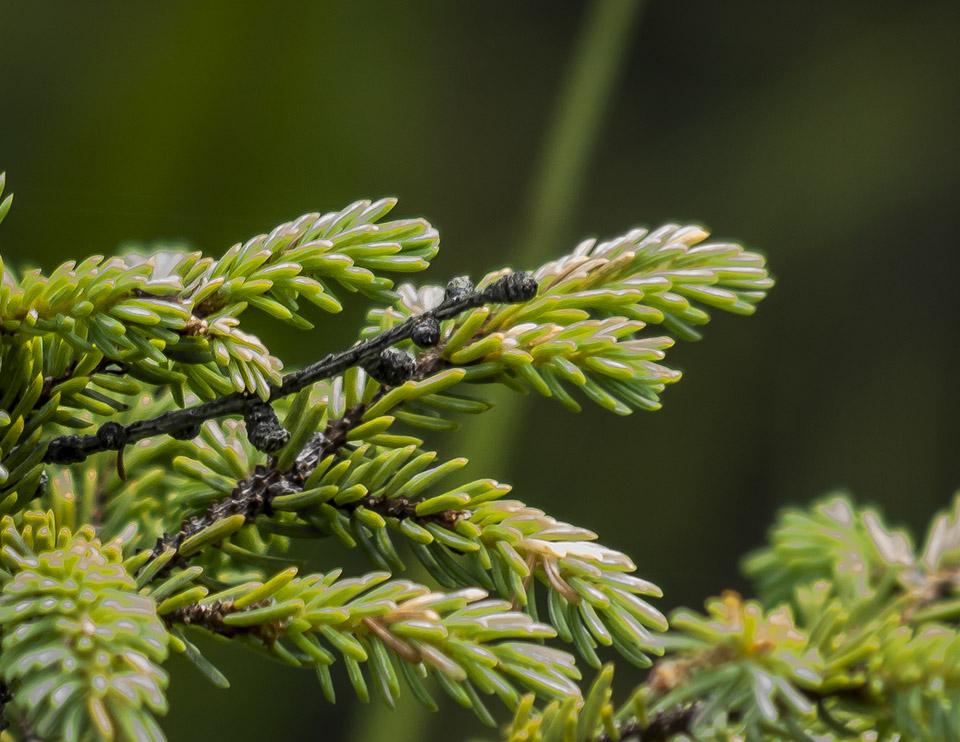
Keys to identifying the Black Spruce include its needles, cones, growth habit, and habitat.
- Like Red Spruce and Balsam Fir, Black Spruce needles are short – about half an inch long – in contrast to the Eastern White Pine, whose needles are generally three to five inches long.
- The needles of the Black Spruce are attached individually to the branches, rather than in clusters.
- In contrast to Balsam Fir and Eastern Hemlock, whose needles appear to occupy a single horizontal plane, the Black Spruce has needles around the entire radius of the branch. Black Spruce needles, like the needles of other spruce trees, are also very hard, making it easy to poke or stick yourself with them.
- Like the needles of other spruce trees, Black Spruce needles have four sides, rather than two, which means that the needles of the Black Spruce are easy to roll back and forth between your fingers. By contrast, Balsam Fir needles are flat.
- Black Spruce needles, like those of other spruce trees, are attached to small, stalk-like woody projections. When its needles are shed, these projections remain, and the branches feel rough to the touch.
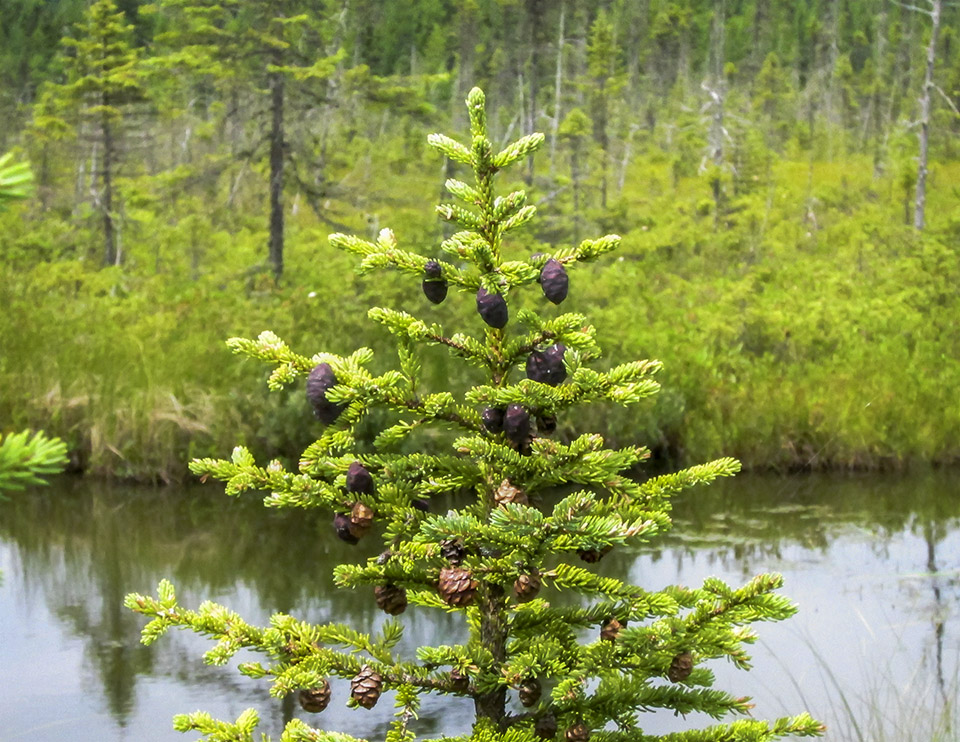
Black Spruce cones are the smallest of all of the spruces. They are egg-shaped to nearly round, usually about ½ to 1½ inches long. They are dark purple, ripening to red-brown. The cones are produced in dense clusters in the upper crown, opening at maturity but persisting for many years.
Black Spruce trees usually start bearing cones when they are thirty years old, although a few cones may be produced after ten years. Black Spruce cones remain partially closed and disperse seed for several years, providing an adequate supply of seeds to reproduce the stand whenever fire occurs.
The bark of young Black Spruce trees is reddish-brown to grayish-brown, often with small, flaky scales. As the tree matures, the bark becomes darker, with large, irregularly shaped, thin scales. Newly exposed bark is olive to yellowish green.
Black Spruce trees, in contrast to other spruces, grow tall and narrowly, as opposed to conically. Black Spruce are slow growers, with a shallow root system which makes the tree susceptible to wind throw. Growth is quite variable, depending upon site conditions.
- Throughout much of its range, trees average 30 to 50 feet in height and 6 to 10 inches in diameter at maturity.
- In wetland areas in the southern parts of its range, including the Adirondack Mountains, especially on bog sites of low fertility, Black Spruce can remain stunted for decades. Trees on the borders of a wetland area tend to be taller, while those in the center may be only five or ten feet tall.
- On Adirondack Alpine summits, Black Spruce trees are also stunted, generally under five feet tall, and often assume twisted forms.
Uses of the Black Spruce
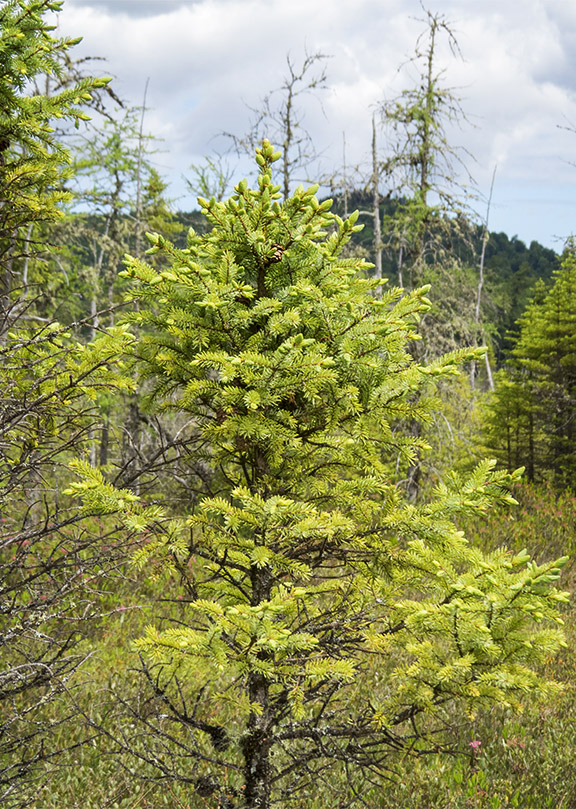
Black Spruce wood is used mainly for pulp. Because the tree is relatively small, lumber is of secondary importance.
- The trees and wood have also been used for fuel and Christmas trees.
- Native Americans used the roots to make trays, buckets, dippers, and spoons. The roots were also used to sew canoes, snowshoes, and birch baskets. The wood was used to make canoe paddles and the pitch to seal seams on birch bark canoes.
Black Spruce has a number of edible uses. The young male catkins reportedly can be used as a flavoring. The central portion of immature female cones, when roasted, is said to be sweet and syrupy. The inner bark is usually harvested in the spring and can be dried, ground into a powder, and then used as a thickener in soups. The seeds reportedly can be eaten raw, as an emergency food. A refreshing tea, rich in vitamin C, reportedly can be made from the young shoot tips. A tea is also made from the needles and the bark.
Black Spruce is also a source of spruce gum and spruce beer.
- In the 19th century, gum pickers on snowshoes gathered resin from Black Spruce using poles fitted with chisels to knock off the resin. Spruce gum should be aged for 3 days or more before using it. The best gum is said to be obtained from the southern side of the tree.
- Spruce beer, which apparently can be made from both Black Spruce and Red Spruce, is made by boiling the young twigs with molasses and sugar; the mixture is then fermented to produce spruce beer. The beer is ready to drink in a week and is considered to be a good source of minerals and vitamins. A spruce beer made by boiling the twigs and cones of Black Spruce reportedly saved the crew of French explorer Jacques Cartier from scurvy in 1536.
Black Spruce reportedly was employed medicinally by many native American tribes for a wide variety of ailments. For example, the Algonquin use the gum of the Black Spruce as a salve. The Cree mixed the pitch of the Black Spruce with grease and used it as an ointment for burns and skin rashes; they also used a decoction of cones as a gargle for sore throats and chewed the cone for toothaches. Eskimos are said to have used a decoction of Black Spruce gum or needles as a treatment for respiratory infections. The Ojibwa used an infusion of roots and barks for stomach pain and fits. A poultice of the inner bark was used as a disinfectant by the Potawatomi to treat inflammations.
Wildlife Value of the Black Spruce
The Black Spruce is a food source for several wildlife species. Snowshoe Hares browse on Black Spruce seedlings and may cause extensive damage to seedlings and saplings when populations of hare are high. Red Squirrels gather cones in large quantities and give a peculiar clumped appearance to the top of the tree. Mice, voles, shrews, and Eastern Chipmunks consume seeds off the ground. Moose and White-tailed Deer browse on Black Spruce only when other food is scarce. This plant is a larval host for the Bog Elfin butterfly.
A number of birds are known feed on Black Spruce, including Spruce Grouse, Pine Grosbeak, Pine Siskin, and White-winged Crossbill. In addition, many boreal birds breed in habitats associated with Black Spruce. These include:
Black-backed Woodpecker
Blackpoll Warbler
Canada Jay
Cape May Warbler
Lincoln's Sparrow
Mourning Warbler
Nashville Warbler
Palm Warbler
Pine Grosbeak
Ruby-crowned Kinglet
Spruce Grouse
White-throated Sparrow
White-winged Crossbill
Yellow-bellied Flycatcher
Yellow-rumped Warbler
Distribution of the Black Spruce
Black Spruce is essentially a Canadian species, in that the bulk of its North American range is in Canada, including British Columbia eastward to Nova Scotia, Newfoundland, New Brunswick, and Quebec. In the US, the Black Spruce's range includes Maine and the other New England states, plus the northern portions of Minnesota and Wisconsin and parts of Alaska. Black Spruce is listed as a plant of special concern in Rhode Island.
Black Spruce has been documented many counties of upstate New York, including the Adirondacks and the Catskills. This species is found in all counties within the Blue Line, except Fulton and Saratoga.
Habitat of the Black Spruce
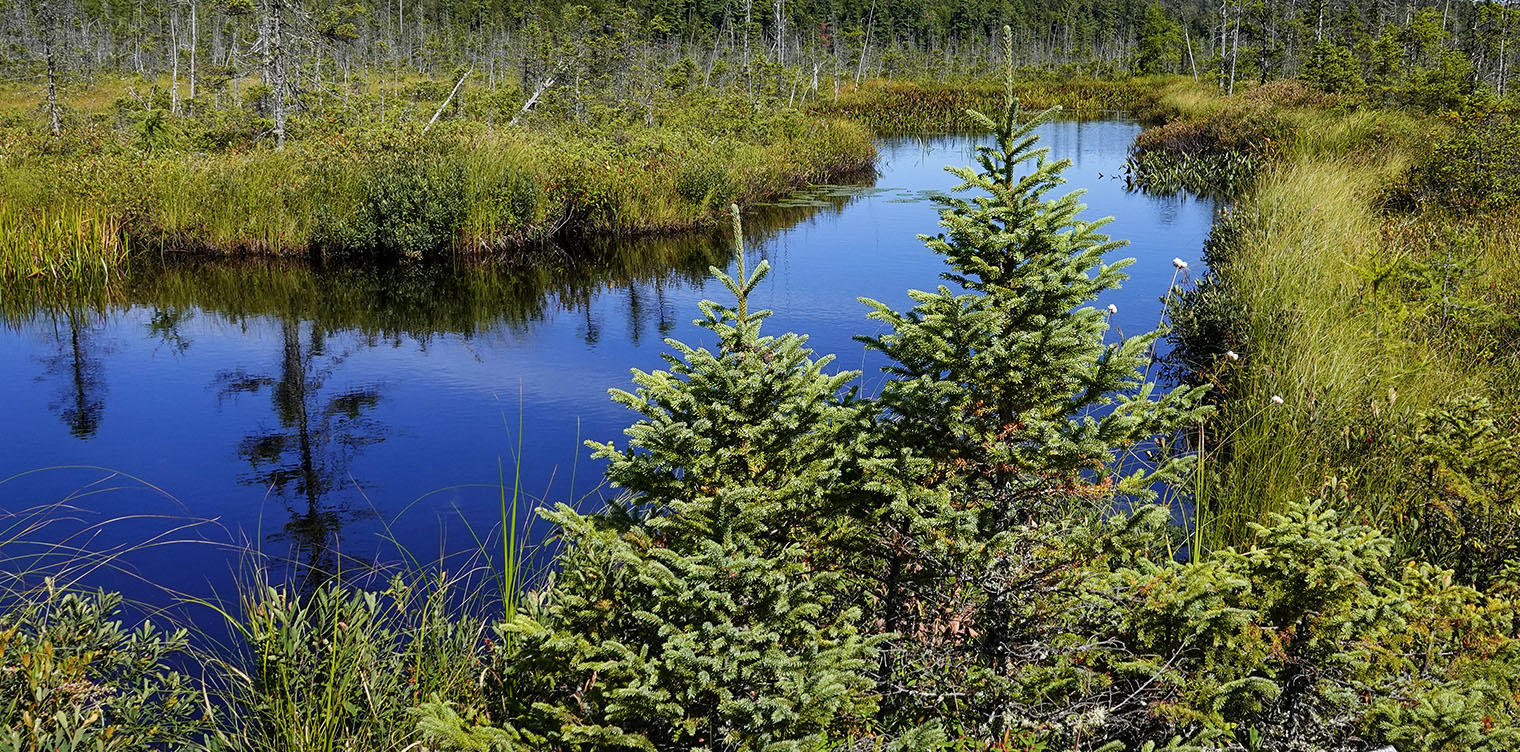
Black Spruce is categorized as a facultative wetland (FACW) plant, which means that it usually occurs in wetlands, but may occur in non-wetlands. This tree tolerates a wide range of soil temperature and moisture regimes. Although this species apparently prefers acidic soils, high soil or water pH may be tolerated. Black Spruce usually grows on wet organic soils, but can also be found across its range on a variety of soil types from deep humus through clays, loams, sands, coarse till, boulder pavements, and shallow soil mantles over bedrock. In general, this species grows in regions with long, cold winters and short, warm summers.
In the Adirondack Mountains, Black Spruce are found on both lowland and upland sites.
- Black Spruce is most abundant in wet soils, especially bogs, where few other species can survive. In these low-nutrient sites, Black Spruce tend to be very small and slow-growing, sometimes taking thirty years or more to grow an inch in diameter.
- Black Spruce is also found on Adirondack alpine summits above 4,500 feet in the high peaks region, growing in a twisted, stunted form together with other arctic plants.
- Black Spruce can also be found on open, severely burned areas, such as the sandy outwash plains south of Quebec Brook in Franklin County.
Throughout the Adirondack region, Black Spruce trees may be found in a number of ecological communities:
Black Spruce can be characterized as a pioneer species. In addition to burned-over sandy plains, this species can also colonize old fields. Black Spruce is more abundant on the northern Adirondack upland (Tupper Lake to Paul Smiths) than on the southern Adirondack upland (Old Forge to Blue Mountain Lake), due to the fact that there are more bogs and outwash plains in the north.
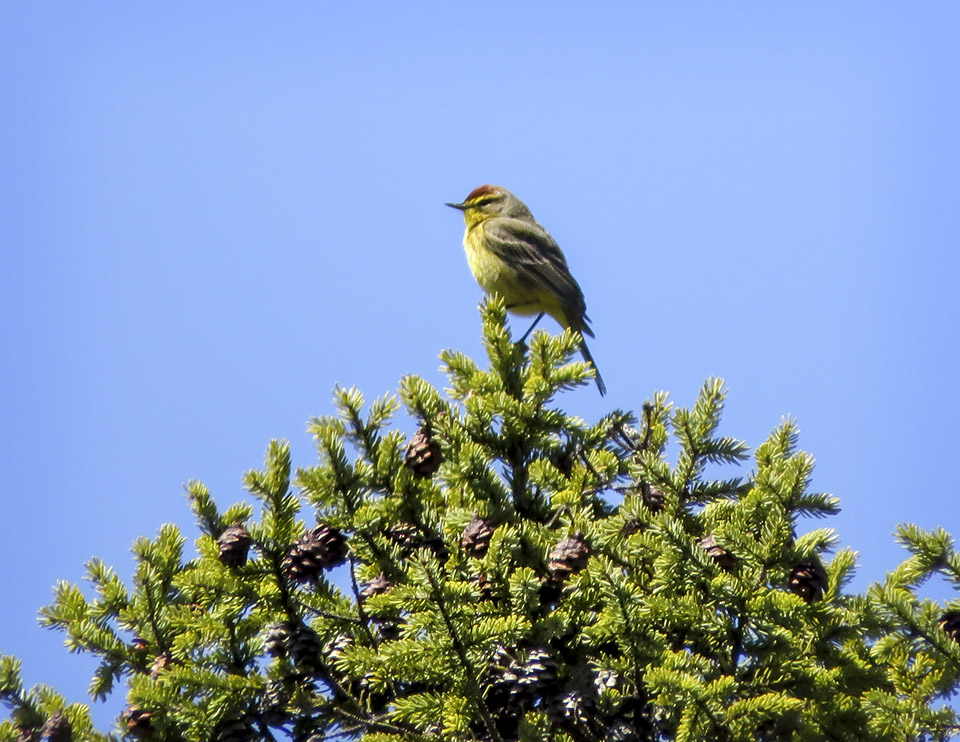
Probably the most convenient place to observe Black Spruce in a bog, its most common environment in our area, is on the Boreal Life Trail at the Paul Smith's College VIC. This trail features a 1,600-foot boardwalk across Barnum Bog. The boardwalk provides viewing access to the many plants and animals that thrive in a bog environment. The Black Spruce is one of the only two tree species to be found here, the other one being the Tamarack.
These two tree species co-exist with a host of bog-dwelling plants. Shrubs, such as Sheep Laurel, Bog Laurel, Leatherleaf, Bog Rosemary, and Labrador Tea, thrive on the thick carpet of sphagnum moss that covers Barnum Bog. Wildflowers, such as Roundleaf Sundew, Pitcher Plant, Buckbean, Cottongrass, and Marsh Cinquefoil share the acidic habitat with Black Spruce. Barnum Bog also hosts a variety of orchids that thrive in wet soil, such as Grass Pink, Rose Pogonia, and White-fringed Orchids.
Several species of birds are often seen perching on or near Black Spruce trees on Barnum Bog or on the edges of the bog, including Yellow-bellied Flycatchers, Cedar Waxwings, and Yellow-rumped Warblers. The Black-backed Woodpecker and the Canada Jay have also been occasionally seen on Barnum Bog or on the edges of the bog. Palm Warblers and Lincoln's Sparrows are known to nest on Barnum Bog and are often seen perching on the tops of the Black Spruce trees which grow on the bog.
Adirondack Tree List
References
Michael Kudish. Adirondack Upland Flora: An Ecological Perspective (Saranac, New York: The Chauncy Press, 1992), pp. 16,41,49,74, 94-95, 248.
Michael Kudish. Paul Smiths Flora II: Additional Vascular Plants; Bryophytes (Mosses and Liverworts); Soils and Vegetation; Local Forest History (Paul Smith's College, 1981), pp. 29, 98, 105.
E. H. Ketchledge. Forests and Trees of the Adirondack High Peaks Region (Adirondack Mountain Club, 1996), pp. 77-80.
New York Flora Association. New York Flora Atlas. Picea mariana. Retrieved 26 February 2017.
United States Department of Agriculture. The Plants Database. Black Spruce. Picea mariana (Mill.) Britton, Sterns & Poggenb. Retrieved 26 February 2017.
United States Department of Agriculture. NRCS National Plant Data Center & the Biota of North America Program. Plant Guide. Black Spruce. Picea mariana (Miller) B.S.P. Retrieved 26 February 2017.
United States Department of Agriculture. Forest Service. Silvics of North America. Black Spruce. Picea mariana (Mill.) B. S. P. Retrieved 16 March 2015.
United States Department of Agriculture. Fire Effects Information System (FEIS). Species Reviews. Picea mariana. Retrieved 26 February 2017.
Flora of North America. Picea mariana (Miller) Britton, Sterns & Poggenburg. Retrieved 26 February 2017.
Native Plant Trust. Go Botany. Black Spruce. Picea mariana (P. Mill.) B.S.P. Retrieved 17 January 2020.
New York State. Department of Environmental Conservation. New York Natural Heritage Program. Ecological Communities of New York State. Second Edition (March 2014), pp. 60-61, 63-64 72, 74-75, 76, 102, 104-105, 122-123. Retrieved 17 October 2015.
New York Natural Heritage Program. 2022. Online Conservation Guide for Alpine Krummholz. Retrieved 29 March 2022.
New York Natural Heritage Program. 2022. Online Conservation Guide for Balsam Flats. Retrieved 29 March 2022.
New York Natural Heritage Program. 2022. Online Conservation Guide for Black Spruce-Tamarack Bog. Retrieved 29 March 2022.
New York Natural Heritage Program. 2022. Online Conservation Guide for Boreal Heath Barrens. Retrieved 29 March 2022.
New York Natural Heritage Program. 2022. Online Conservation Guide for Dwarf Shrub Bog. Retrieved 29 March 2022.
New York Natural Heritage Program. 2022. Online Conservation Guide for Inland Poor Fen. Retrieved 29 March 2022.
New York Natural Heritage Program. 2022. Online Conservation Guide for Northern White Cedar Swamp. Retrieved 29 March 2022.
New York Natural Heritage Program. 2022. Online Conservation Guide for Open Alpine Community. Retrieved 29 March 2022.
New York Natural Heritage Program. 2022. Online Conservation Guide for Patterned Peatland. Retrieved 29 March 2022.
New York Natural Heritage Program. 2022. Online Conservation Guide for Spruce Flats. Retrieved 29 March 2022.
New York Natural Heritage Program. 2022. Online Conservation Guide for Spruce-Fir Swamp. Retrieved 29 March 2022.
New York State. Adirondack Park Agency. Preliminary List of Species Native Within the Adirondack Park Listed Alphabetically by Scientific Name and Sorted by Habit. Volume 1. Updated 10.23.2006, p. 7. Retrieved 26 January 2017.
Lady Bird Johnson Wildflower Center. Picea mariana. Retrieved 26 February 2017.
University of Wisconsin. Trees of Wisconsin. Picea mariana. Retrieved 14 January 2015.
Online Encyclopedia of Life. Picea mariana. Retrieved 14 January 2015.
William K. Chapman and Alan E. Bessette. Trees and Shrubs of the Adirondacks: A Field Guide (North Country Books, 1990), p. 22, Plate 4.
Stan Tekiela. Trees of New York: Field Guide (Adventure Publications, Inc., 2006), pp. 4-5 .
Michael Wojtech. Bark: A Field Guide to Trees of the Northeast (University Press of New England, 2011), pp. 188-189.
Nancy G. Slack and Allison W. Bell. Adirondack Alpine Summits: An Ecological Field Guide (Adirondack Mountain Club, Inc., 2006), p. 59.
John Eastman. The Book of Swamp and Bog: Trees, Shrubs, and Wildflowers of Eastern Freshwater Wetlands (Stackpole Books, 1995), pp. 172-178.
Ronald B. Davis. Bogs and Fens. A Guide to the Peatland Plants of the Northeastern United States and Adjacent Canada (University Press of New England, 2016), pp. 54-57.
University of Michigan. Native American Ethnobotany. A Database of Foods, Drugs, Dyes and Fibers of Native American Peoples, Derived from Plants. Picea mariana (P. Mill.) B.S.P. Retrieved 26 February 2017.
Plants for a Future. Database. Retrieved 14 January 2015.
Steven Foster and James A. Duke. Medicinal Plants and Herbs of Eastern and Central North America (Houghton Mifflin Harcourt, 2014), pp. p. 343.
Bradford Angier. Field Guide to Edible Wild Plants. Revised and Updated. (Stackpole Books, 2008), p. 218.
The Birds of North America. Ruby-crowned Kinglet; Palm Warbler; Lincoln's Sparrow; Black-backed Woodpecker; Nashville Warbler; Canada Jay; Pine Grossbeak; Yellow-rumped Warbler; Cape May Warbler; Mourning Warbler; Spruce Grouse; Yellow-bellied Flycatcher; White-throated Sparrow; Bay-breasted Warbler; White-winged Crossbill. Tennessee Warbler. Subscription Web Site. Retrieved 14 January 2015.
Butterflies and Moths of North America. Bog Elfin, Retrieved 26 February 2017.
George A. Petrides. A Field Guide to Eastern Trees (Boston: Houghton Mifflin Company, 1998), pp. 38-39, 173-174.
John Kricher. A Field Guide to Eastern Forests. North America (Boston: Houghton Mifflin, 1998), pp. 67-70, 124-125.
R.C. Hosie. Native Trees of Canada. Eighth Edition (Fitzhenry & Whiteside Ltd., 1979), pp. 72-73, 339. Retrieved 28 February 2019.
William Freeman Fox. The Adirondack Black Spruce (Albany: James B. Lyon, Printer, 1895). Retrieved 13 January 2015.
Trees of the Adirondack Mountains
